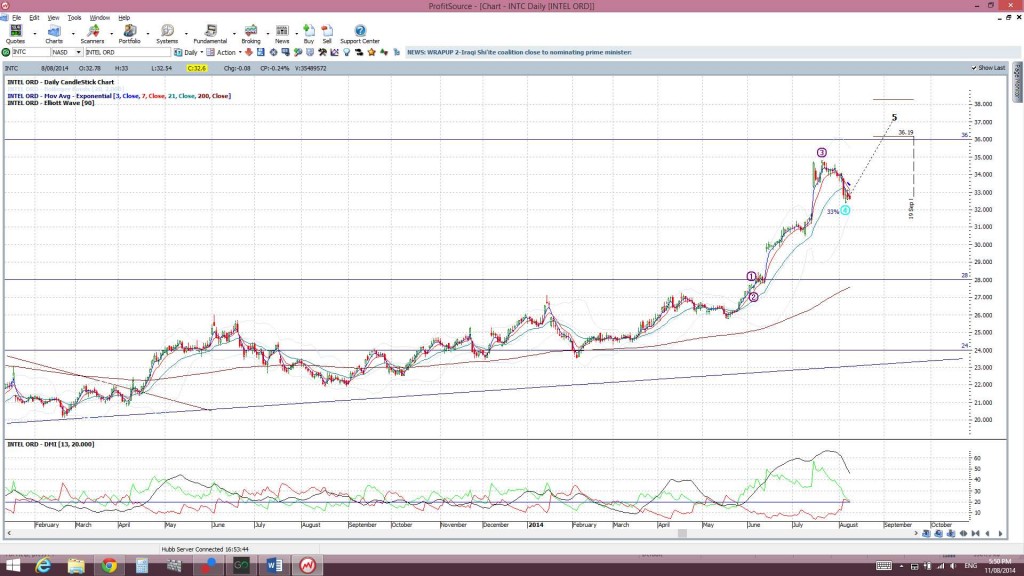I am often asked about my Option trading. I use options to earn regular income. There are risks associated with any trading but with careful stock selection Option traders can work to manage these risks.
Although I reside in Australia I generally trade Options on U.S. shares as the liquidity is generally very good and the spreads (the difference between the bid and offer price) are generally quite tight.
Selling Put Options
My preferred Option trading strategy is to write (or “sell to open”) Put Options. This is how I started using Options and it remains as my main Option strategy today.
When you “sell a put option”, you are agreeing to buy a stock cheaper if it falls to your agreed buy price, or even lower, by the expiration of your Option contract. You’re paid for the Option you sell and, no matter what happens, you keep that money.
Why are you paid to sell these options? Because it is a bit like selling someone an insurance policy on a stock. By selling a Put Option, you are essentially saying to the Option buyer that, “If your stock falls below $32 by September 2014 (for example), I’ll buy it from you at $32.” They pay you an up-front Option premium for that insurance.
Sell to Open Puts on INTEL Corporation: Trade Idea on 11th August 2014
INTEL (NASDAQ: INTC) Intel Corporation develops integrated digital technology products for industries such as computing and communications. Intel has a market capitalisation of over US $160 billion and employs over 100,000 personnel. It is currently trading at $32.60, at the time of writing this article, with a P/E ratio of about 14, positive cash flow and an average volume of shares traded @ just under 34 million. I use Morningstar on-line service to help assess the stocks I trade.
Technically, INTC made a bullish breakout above the long term $28 resistance level back in June 2014. Price has held above this level since then and was recently trading at just under $35. The monthly chart shows that the $36 level is another long term S/R level and price has recently respected this resistance.
INTC monthly
INTC weeekly
INTC daily
Traders or investors wanting to purchase INTC shares have two methods by which they could achieve this:
-
- Buy the stock at the next market open for $32.60, or thereabouts, OR
- You could potentially buy the shares even cheaper by writing (selling) a Put Option, getting paid while you wait, and setting up a lower potential buy price.
The INTC Put Option Trade:
INTC Puts: The $32 INTC September 20th 2014 Puts are currently able to be sold for 0.60 cents. This is just under 6 weeks away from today’s date with 40 days to option expiry.
This means you would be agreeing to buy INTC shares if they fall to $32, or even lower, on or before September 20th and if the person buying your option wants to sell the shares. They would really only want to do this if INTC shares fall to $32 or below. For this agreement you are paid $0.60 cents per single share.
One Option contract covers 100 shares and, thus, for INTC controls $3,200 worth of shares. This Sept 20th 2014 Put option is worth $60 per Option contract. For each Option contract you sell you are actually agreeing to pay $3,200 for 100 shares on or before Sept 20th 2014 and you are being paid $60 to do so:
- 1 Put contract controls 100 shares worth $3,200 and earns you $60.
- 2 Put contracts controls 200 shares worth $6,400 and earns you $120.
- 3 Put contracts controls 300 shares worth $9,600 and earns you $180.
Traders would take this kind of Put Option trade because:
- They want to own INTC shares and this method allows them to potentially buy them at a discount to today’s current price.
- They are actually being paid for their patience to buy the shares on any potential pull back.
The $0.60 cents may not seem like much but this equates to an annual return on invested capital (AROIC) of around 17%:
AROIC= [($0.60 / $32) x (365/40)] x 100 = 17%
Here are the possible outcomes for this trade:
-
- INTC stock is higher than $32 at expiration: Your Put Option expires. You keep the $0.60 per share earning an AROIC of 17%.
-
- INTC stock is at $32 or lower at expiration: You can buy to close your puts and end your obligation before the Option expiration date if you like, earning a profit if you can buy your put options back for less than you were paid. If you keep the Put Option contract open then you are obliged to buy INTC at $32. But you still keep the $0.60 you were paid, so your net buying price is $32 – $0.60 = $31.40 cents. That is, you get to buy INTC at a discount to today’s price.
The mechanics of the trade:
- I’m going to write, or “sell to open,” three Sept 2014 $32 put options. This means that I’m potentially obliged to buy $9,600 (300 shares x $32) worth of INTC shares if they fall to $32, or below, by 20th September 2014.
- My broker will deposit $180 ($60 x 3 = $180) into my brokerage account and, no matter what happens, that money is mine to keep.
Summary: Selling Puts Options is an income strategy that lets you buy stocks cheaper if they decline. When stocks don’t decline, this strategy can result in continued income. Many income-oriented investors look to write Put Options each month on safe, strong companies. I will only sell Put Options on stocks that I am prepared to own and sell Puts at strike prices at which I am prepared to own the stock. The random selling of Put Options on stocks is very high-risk and should be avoided. Traders need to carry out their own due diligence and trade within the safety of their risk profile and only with funds they allocate for trading.





